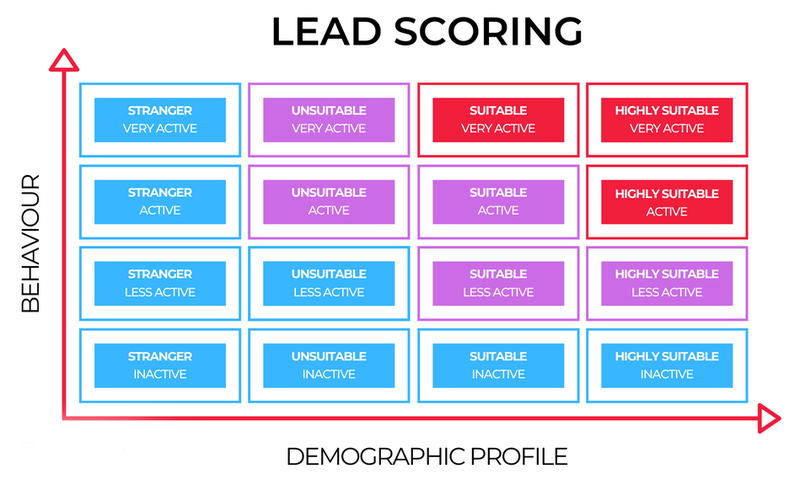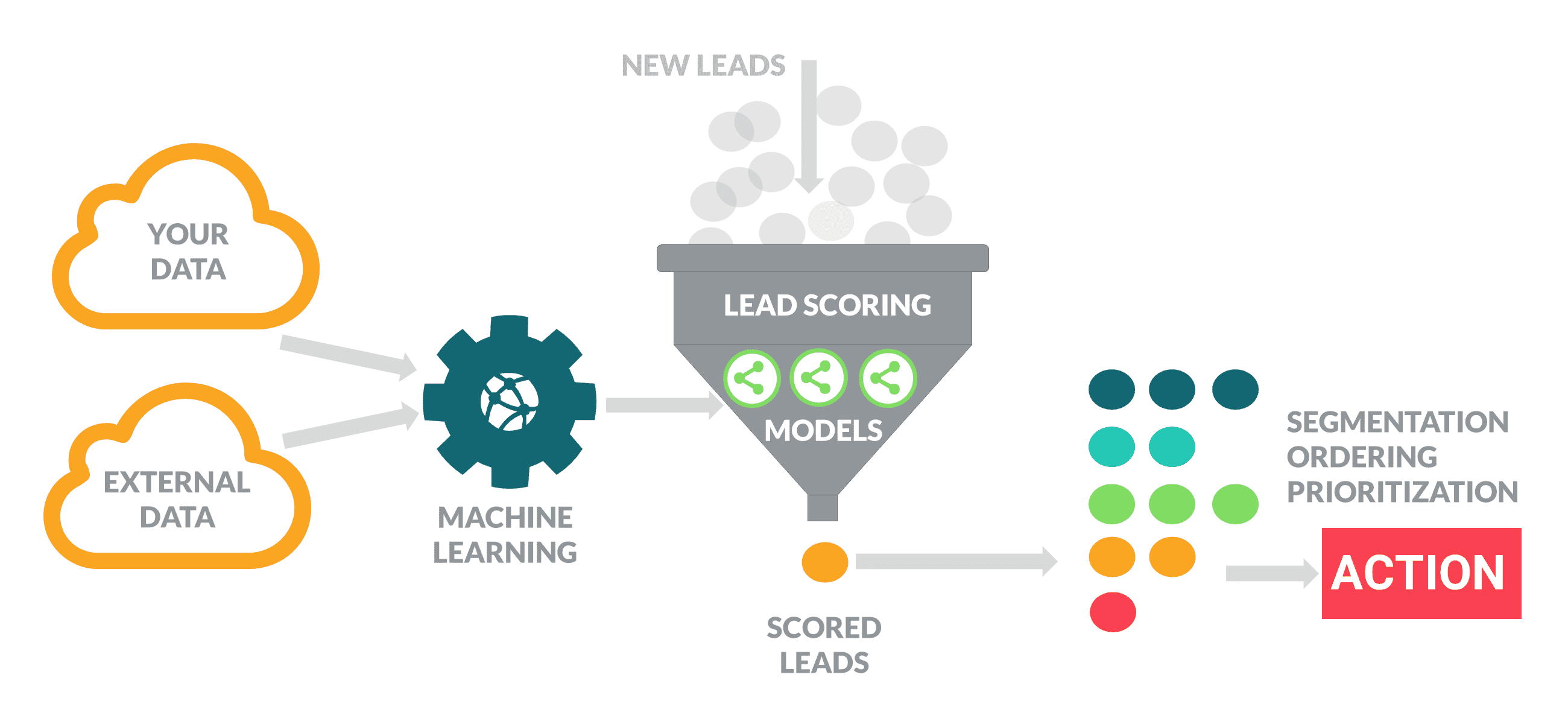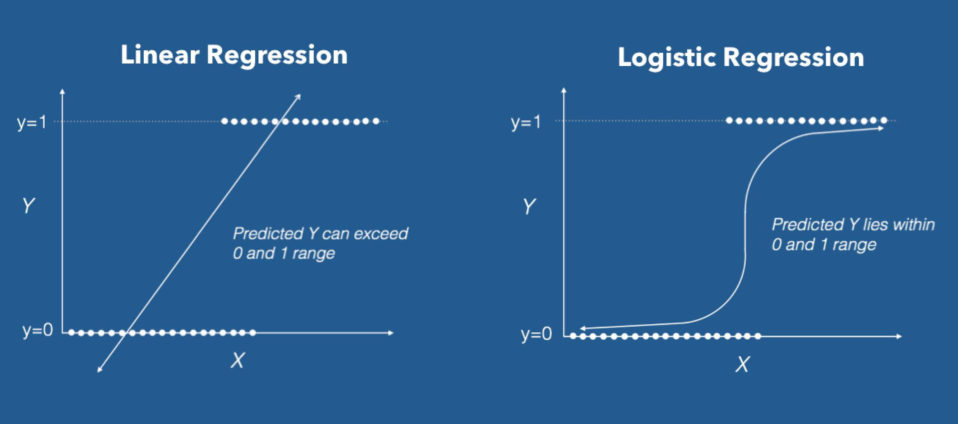Do you use your CRM system for your lead and customer evaluation and perhaps even with integrated marketing automation? You’re on the right track, but you can do even better: the next step is predictive lead and customer scoring.
In an age of automation and advanced analytics, relying on guesswork to find leads is the most ineffective approach. You probably don’t want to rely on this approach to build customer and lead relationships, and you certainly don’t want to rely on randomization to succeed. For this reason, you must determine the right client’s portrait, and this is why assessing leads will be your best strategy.
A CRM system with automatic lead scoring as one of the automation tools allows you to quickly exchange data, reduce costs, increase the number of applications, and also allows to build trust and long-term relationships with potential clients who are “worthwhile,” thereby sourcing better deals and making the sales pipeline more robust.
AI Impact on the Future of Business
The evolution of business automation tools is also moving forward in general, and CRM systems in particular. Filling in customer data, scoring leads, analytics, and other operations, in part, required more human involvement than it does today. To date, advances in deep learning and AI, in particular, are helping society and businesses solve a more comprehensive range of common problems.
Artificial intelligence (AI) is being introduced, plunging into the business world. Leading companies across industries are leveraging their capabilities, from banks to marketplaces deploying chatbots to improve customer engagement.
Deep learning (a subset of machine learning) has yet to be fully explored. But we believe it will help societies and businesses tackle a broader set of challenges soon, as AI has tremendous potential to improve organizations’ work. For the foreseeable future, AI will enable companies to continually adapt processes based on previous experience – for example, leading to significant improvements in customer targeting because deep learning algorithms can identify behaviors that are more likely to lead to sales.
Lead Scoring and its Business Value
What Is Predictive Lead Scoring? Lead scoring is how a presale or sales team evaluates the value of any potential lead. Each business has its own set of metrics that let them know how interested a potential buyer is in their product or service.
Call centers need CRM software to deliver specific insights that improve first call resolution and customer satisfaction. Call center or sales software suites, including tools like Salesforce and Hubspot, track customer needs and provide actionable insights, but lead assessment takes those insights to the next level. When combined with tools like Phonewagon for tracking calls, you can get the most out of each.
The lead assessment identifies the customer profile as accurately as possible, using customer data to determine who is more likely to take a targeted action (place an order, for example). There is a gamification aspect to evaluating leads, as customers with higher scores are so for a reason and are hence on average, inherently more valuable. When you combine these tools with predictive behavioral routing, you send calls to the best-equipped managers to close the deal.
For example, when a prospect enters your sales funnel, specific criteria determine their value. From what vector does the lead get into the funnel? Is he or she referring to you because they saw something on your site? Has the customer bought other products from your company or participated in other programs?

These pre-existing criteria will add a numerical value to their lead score, which can be used to prioritize the customer.
The right lead scoring solution is ideal for identifying those interested in your brand and filtering out those that could ultimately lead to unproductive and ineffectual customer negotiations.
It is also useful when dealing with B2B customers – your lead scoring solution may assign lower scores to some potential leads depending on the company’s size or the geographic region in which the company does business. All you need to do is define your ideal customer profile, and the assessment process can begin. We have written a lead assessment guide that considers specifics, including implicit criteria, negative criteria, and how to assess the viability of the data you collect.
What are the Disadvantages of Traditional Lead counting?
While traditional lead scoring is excellent for companies just at the beginning of their journey, it has certain drawbacks. Let’s take a look at some of them that can affect your bottom line:
- It is not so valuable if there are few potential customers.
- It’s useless if your salespeople aren’t actively pursuing leads in real-time.
- It requires specific data points to be established in advance. If the business is new, this data is not always known.
- Leads are not always accurately assessed using this system, as this system is based on the judgments of sales managers and marketers.
For those reasons, a more streamlined system should be used. Artificial Intelligence and Big Data are a big part of today’s business, so it is a no-brainer that predictive lead counting based on machine learning is growing as it continues being implemented in the corporate world.
What is Predictive Lead Scoring, and How it Increase Sales?

Predictive Lead Counting is designed to use your analytics data to find ideal leads directly. Traditional lead scoring can fail due to human error, but predictive lead scoring prevents most mistakes.
CRM software can be used to attribute scoring values to your [prospective] customers, and predictive lead scoring solutions will perform the assignment of these scores automatically. “Predictive” in predictive lead scoring refers to predictive modeling based on a series of algorithms. These algorithms are designed to find your perfect or near-perfect customer, so your salespeople don’t have to guess, especially if you’ve been tracking call performance using call recording data.
By using historical and demographic data, a much more accurate and reliable dataset is generated. Since this is all based on machine learning, the forecasting solution will consider criteria that your marketing team will miss out on, resulting in a gap between the number and quality of leads that the two methods generate and offer. The best part? Because this is done with machine learning and predictive analytics, many processes can run concurrently, freeing your team up for other tasks.
Such software not only builds on real-world results but analyzes what didn’t work to try and recruit customers. It also looks at information that clients share to analyze demographic data to estimate how likely certain leads are to be good customers; your team then uses this information to outreach these targets, which can also be automated in and of itself to a certain extent.
Predictive Lead Scoring uses various lead scoring models to create a methodology. Logistic regression is used in many solutions. Logistic regression is a data mining algorithm that calculates the likelihood of developing a customer from a lead.

Logistic regression is formula-based and can significantly reduce the number of bad leads. Traditionally, marketers have built these algorithms using Excel. With a predictive model, this is done quickly, and once set up, there is no extra work required on the part of your team.
Another tool used by the prospect predictive scoring system is random forests. This type of algorithm creates a forest of “decision trees” that you can use to map your customers’ behavior. Namely, using this method will create a virtual decision forest, and the tool will use this decision forest to determine which interests are more likely to convert.
This methodology uses randomization, which can help identify some of the factors that can drive conversions when zoomed in.
What are the Benefits of Predictive Lead Scoring?
The main benefit of predictive prospecting is that it removes a lot of assumptions about your sales funnel. Your sales managers will be able to:
- Eliminate errors in analysis
- Make confident decisions based on rich data
- Find hidden relationships between datasets
- Get a 360-degree view of how each piece of data connects.
Predictive Algorithms Qualify Leads
As explained, forecasting algorithms are employed to qualify potential customers. But what are the exact methods of deploying these algorithms?
In many cases, algorithms can be used for predictively assessing interests to determine rating factors independently, but some general criteria can be used to evaluate those interests overall. They may include:
CRM solutions with AI lead scoring
There are many solutions available on the market today that assess potential customers. In this section, we’re going to provide you with four of the most reliable options so you can separate the wheat from the chaff with less effort.
HubSpot
One of HubSpot’s predictive prospecting solution’s best features is that it is already included in one of the most popular marketing automation platforms currently on the market. Their solution is available to all corporate-grade clients, which is excellent for those who want to work consistently.
The solution comes with a default model based on templates used by successful customers, but there is significant customization for those who need it.
This solution is ideal for those who already store busy and unoccupied contacts in HubSpot. The software included in the app will determine which customers fall into the low, medium, or high rated lead categories. The program even provides a pie chart based on several analytical criteria.
| Pros | Cons |
|
|
PipeCandy
Solutions like PipeCandy work just as well in B2B as they do in D2C and e-commerce. As a result, PipeCandy is an excellent tool for organizations looking to partner with other companies in that particular space or sell them to other companies.
PipeCandy integrates seamlessly with your CRM to determine wins and losses to generate new valuation results for your leads. The analytics and metrics are also intuitive and provide a well-organized visualization that you can use to adjust your strategy.
PipeCandy works well for companies with small datasets through its Attribute Importance feature. This feature allows managers to decide which factors are most important when evaluating leads.
| Pros | Cons |
|
|
Infer
Unlike HubSpot, Infer is a dedicated lead scoring platform that is designed to connect to your CRM or marketing automation solution. The software uses a live API connection that allows it to connect seamlessly to just about any CRM solution currently available or available in the future.
The software also allows managers to seamlessly utilize thousands of data points based on firmographic, technographic, or demographic information. The software even has built-in information on 19 million companies and 42 million prospects. Like the best predictive software, it’ll even use machine learning to identify patterns in both B2B and customer prospects using data extracted from your CRM.
| Pros | Cons |
|
|
AI & Machine Learning For Predictive Lead Scoring
Predictive analytics through machine learning can provide your sales and marketing team with in-depth customer insights and ways to target the hottest and most qualified leads, resulting in time savings and increased revenue streams.
How can machine learning improve lead scoring?
One of the best approaches to make a precise prediction for the potential leads is to use machine learning. It allows training the algorithms using the historical data company has and to make an ‘assumption’ on the likelihood of the deal to happen. The algorithm will analyze the trends and patterns, eventually building a prediction model, which then can be applied to the new potential customers. These models need to be retrained periodically to ensure the latest data is used as well.
Such models by sales teams will drastically increase the scoring speed i.e., improving the overall sale process. It allows sales managers to concentrate on the sales efforts rather than the ranking process.
Of course, you can find lots of quotes from famous CEOs saying making mistakes is ok, and you just need to learn from them, but nobody wants to make the mistakes, especially if they could be avoided. In the end, we are all humans, and we make mistakes, your sales team too! Wrong or too slow lead scoring is something that affects lots of businesses, so the main idea here is a step away from the human factor.
Applying machine learning to lead scoring is all about speed, accuracy, and focusing.
How much data is required?
For predictive analytics to be effective, machine learning requires a large amount of historical data. It is essential not to overlook minor factors that can be critical to the results.
A machine learning algorithm can only work with the historical data it has. If your dataset is too small or inaccurate, this can lead to incorrect results. For example, if you collect data about customers for a year who bought a particular product and among these customers, several bought it by mistake. The model will not consider and extrapolate this propensity to purchase and apply it to the future customer’s predictions.
These customers will not be inclined to make such purchases. It means that to get the most accurate predictions, you will need a large dataset to allow the machine learning algorithm to recognize the underlying trends in the data and what is just noise in the data.
Steps in the machine learning process
After setting the task and successfully assessing potential customers, the data is analyzed to identify patterns in the large dataset. The training dataset is usually based on expert knowledge when the labels or ratings of these customers are known precisely. An algorithm is applied to this dataset, where descriptive functions are related to the objective function, and a prediction model is created.
You can then load practical query examples (for example, can this customer convert) into this forecasting model and make predictions. Based on the forecasts generated by this approach, companies adjust their business strategies. If the enterprise is sufficiently automated, it can be done programmatically; otherwise, it is done manually.
How to develop a lead scoring app with AI?
The development of a web application is a complex procedure that requires numerous specialists and steps. So it is crucial to get prepared and understand what tech takes you to need to hire and what processes will be completed during the development.
First of all, we would like to mention who is going to be responsible for your predictive lead scoring solution creation. You will need to cooperate with:
- Business Analysts who will help you shape your idea, do market research, identify technology stack, and write specifications for your future app.
- Web developers who will write high-quality code.
- UI/UX designer who is going to be responsible for the look of your solution. Every element starting with the app buttons and ending with the loaders will be created by this professional.
- QA engineers will perform various tests to check the quality of code, bugs and errors, connectivity and compatibility of services, and much more.
- Scrum Master under whose supervision the development will be performed. This specialist will take care of all organizational aspects, ensure that everything is done on time and that no deadlines are missed.
Now that you know what specialists you need/should be looking for let’s clear out how to find them and make sure that the team you’ve selected is the perfect fit for your project needs.
Find a team
It is pretty challenging to find a suitable team to entrust with your app idea development. So when you start looking for it, you will probably be considering using such options as:
In-house team
As part of this approach, your company needs to find and hire the right specialists themselves, such as business analysts, project managers, HTML / CSS specialists, front-end and back-end developers, designers, quality assurance engineers. It is a rather long, complex, and arduous process that requires a lot of resources. Also, suppose you need to develop a single solution. In that case, this approach is not cost-effective because you need to create jobs and constantly maintain the load on the team, which will be extremely difficult after the development process is completed.
Outsourcing team
Outsourcing a development team is always a win-win. Compared to its alternatives, it has many advantages that will save you time and money. Outsourcing means hiring the entire development team that is required for your project together. The main difference between outsourcing and an in-house team is that you, as a client, only pay for development hours, meaning there is no need to pay each team member if one of the specialists has already completed a specific part of the project. With all that said, the critical benefits of the outsourcing development team option are:
- More solid path to profitability;
- The team is fully focused on your project and industry specifications;
- As a client, you continue to run your business without interruption or loss.
While looking for a developers team, try to check such reliable platforms as Cutch or Goodfirms. Compare the companies that are up to your liking, pay special attention to things like their hourly rates, experience in web development, areas, or industries of expertise. Don’t forget to take a look at the portfolios and real examples of apps they’ve built.
We would also recommend you choose the European developers since they offer high quality of services. They are easy to communicate with, and their rates are quite affordable compared to American companies.
Development tips of predictive lead scoring
Reliable APIs
If you are going to develop an app for an existing CRM system, you need to use the APIs of your solution. So they are required to make an app work and make it possible to use information about all the leads in progress and ongoing.
High level of security
It is one of the most crucial characteristics of the CRM system since it operates critical business information that can be valuable. Talking about the technical side of the security, consider adding encryption systems, electronic signatures support, etc.
Intuitive and clear UI/UX
Since the users of your system will be users of different ages and with different experiences, everything should be visible, readable, and easy to comprehend and find. The color scheme should not be aggressive or too bright, as sales managers will work with the solution all day long. The buttons, sections logic, loaders – all these elements are crucial and should be taken care of.
FAQ
To sum up
Lead scoring is critical for business; otherwise, it can lead to inefficient waste of resources and loss of profits. Predictive scoring of potential customers eliminates the possibility of such losses. These solutions can help organizations identify target markets, prioritize leads, and reduce the burden on marketing teams and the sales department.
Predictive Lead Counting is a tool you should use to get the most out of your company’s resources. The more you use a solution like this, the more it will increase your ROI as AI learns from both wins and losses.
Overall, software like this can help you better manage your sales funnel to increase the likelihood of closing in an almost entirely automated process.






